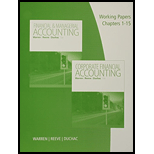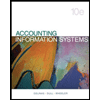
Working Papers, Volume 1, Chapters 1-15 for Warren/Reeve/Duchac's Corporate Financial Accounting, 13th + Financial & Managerial Accounting, 13th
13th Edition
ISBN: 9781285869582
Author: Carl Warren, James M. Reeve, Jonathan Duchac
Publisher: Cengage Learning
expand_more
expand_more
format_list_bulleted
Concept explainers
Question
Chapter 26, Problem 26.6CP
To determine
Activity-based costing (ABC) method: The costing method which allocates
To list: Few activities and their activity bases for ‘checking and savings account’ product line
Expert Solution & Answer
Want to see the full answer?
Check out a sample textbook solution
Students have asked these similar questions
Hii teacher please provide for General accounting question answer do fast
General accounting question
ABC Company has December unit sales of 12,000 units. Assuming a 5 percent growth, what is the projected unit sales?
Chapter 26 Solutions
Working Papers, Volume 1, Chapters 1-15 for Warren/Reeve/Duchac's Corporate Financial Accounting, 13th + Financial & Managerial Accounting, 13th
Ch. 26 - Why would management be concerned about the...Ch. 26 - Why would a manufacturing company with multiple...Ch. 26 - How do the multiple production department and the...Ch. 26 - Under what two conditions would the multiple...Ch. 26 - Prob. 5DQCh. 26 - Prob. 6DQCh. 26 - Prob. 7DQCh. 26 - Under what circumstances might the activity-based...Ch. 26 - Prob. 9DQCh. 26 - Prob. 10DQ
Ch. 26 - Single plantwide factory overhead rate The total...Ch. 26 - Single plantwide factory overhead rate The total...Ch. 26 - Multiple production department factory overhead...Ch. 26 - Multiple production department factory overhead...Ch. 26 - Activity based costing: factory overhead costs The...Ch. 26 - Activity-based costing: factory overhead costs The...Ch. 26 - Activity-based costing: selling and administrative...Ch. 26 - Activity-based costing: selling and administrative...Ch. 26 - Activity-based costing for a service business...Ch. 26 - Activity-based costing for a service business...Ch. 26 - Single plantwide factory overhead rate Nixon...Ch. 26 - Single plantwide factory overhead rate Matts Music...Ch. 26 - Single plantwide factory overhead rate Sally...Ch. 26 - Prob. 26.4EXCh. 26 - Multiple production department factory overhead...Ch. 26 - Single plantwide and multiple production...Ch. 26 - Single plantwide and multiple production...Ch. 26 - Identifying activity bases in an activity-based...Ch. 26 - Product costs using activity rates Nozama.com Inc....Ch. 26 - Prob. 26.10EXCh. 26 - Prob. 26.11EXCh. 26 - Activity cost pools, activity rates, and product...Ch. 26 - Activity-based costing and product cost distortion...Ch. 26 - Multiple production department factory overhead...Ch. 26 - Activity-based costing and product cost distortion...Ch. 26 - Single plantwide rate and activity-based costing...Ch. 26 - Evaluating selling and administrative cost...Ch. 26 - Prob. 26.18EXCh. 26 - Prob. 26.19EXCh. 26 - Activity-based costing for a service company...Ch. 26 - Activity-based costing for a service company...Ch. 26 - Single plantwide factory overhead rate Orange...Ch. 26 - Multiple production department factory overhead...Ch. 26 - Activity-based and department rate product costing...Ch. 26 - Prob. 26.4APRCh. 26 - Prob. 26.5APRCh. 26 - Product costing and decision analysis for a...Ch. 26 - Single plantwide factory overhead rate Spoiled Cow...Ch. 26 - Multiple production department factory overhead...Ch. 26 - Activity-based department rate product costing and...Ch. 26 - Activity-based product costing Sweet Sugar Company...Ch. 26 - Allocating selling and administrative expenses...Ch. 26 - Product costing and decision analysis for a...Ch. 26 - Prob. 26.1CPCh. 26 - Prob. 26.2CPCh. 26 - Activity-based costing for a service company Wells...Ch. 26 - Using a product profitability report to guide...Ch. 26 - Prob. 26.5CPCh. 26 - Prob. 26.6CP
Knowledge Booster
Learn more about
Need a deep-dive on the concept behind this application? Look no further. Learn more about this topic, accounting and related others by exploring similar questions and additional content below.Similar questions
arrow_back_ios
SEE MORE QUESTIONS
arrow_forward_ios
Recommended textbooks for you
 Accounting Information SystemsAccountingISBN:9781337619202Author:Hall, James A.Publisher:Cengage Learning,Principles of Accounting Volume 1AccountingISBN:9781947172685Author:OpenStaxPublisher:OpenStax College
Accounting Information SystemsAccountingISBN:9781337619202Author:Hall, James A.Publisher:Cengage Learning,Principles of Accounting Volume 1AccountingISBN:9781947172685Author:OpenStaxPublisher:OpenStax College College Accounting (Book Only): A Career ApproachAccountingISBN:9781337280570Author:Scott, Cathy J.Publisher:South-Western College Pub
College Accounting (Book Only): A Career ApproachAccountingISBN:9781337280570Author:Scott, Cathy J.Publisher:South-Western College Pub Auditing: A Risk Based-Approach (MindTap Course L...AccountingISBN:9781337619455Author:Karla M Johnstone, Audrey A. Gramling, Larry E. RittenbergPublisher:Cengage Learning
Auditing: A Risk Based-Approach (MindTap Course L...AccountingISBN:9781337619455Author:Karla M Johnstone, Audrey A. Gramling, Larry E. RittenbergPublisher:Cengage Learning Pkg Acc Infor Systems MS VISIO CDFinanceISBN:9781133935940Author:Ulric J. GelinasPublisher:CENGAGE L
Pkg Acc Infor Systems MS VISIO CDFinanceISBN:9781133935940Author:Ulric J. GelinasPublisher:CENGAGE L

Accounting Information Systems
Accounting
ISBN:9781337619202
Author:Hall, James A.
Publisher:Cengage Learning,

Principles of Accounting Volume 1
Accounting
ISBN:9781947172685
Author:OpenStax
Publisher:OpenStax College

College Accounting (Book Only): A Career Approach
Accounting
ISBN:9781337280570
Author:Scott, Cathy J.
Publisher:South-Western College Pub

Auditing: A Risk Based-Approach (MindTap Course L...
Accounting
ISBN:9781337619455
Author:Karla M Johnstone, Audrey A. Gramling, Larry E. Rittenberg
Publisher:Cengage Learning

Pkg Acc Infor Systems MS VISIO CD
Finance
ISBN:9781133935940
Author:Ulric J. Gelinas
Publisher:CENGAGE L